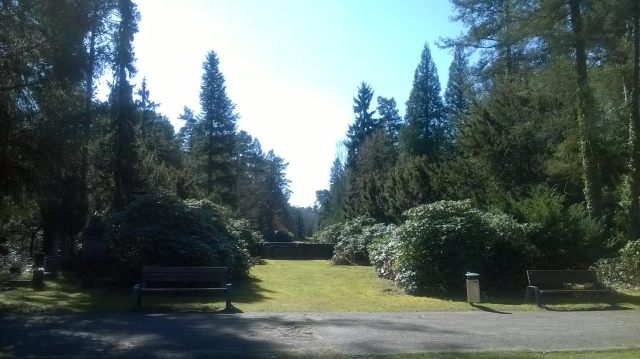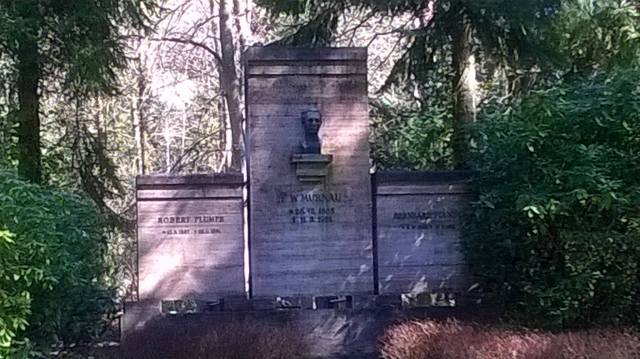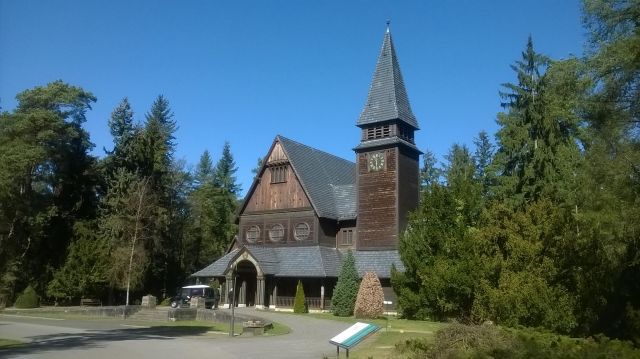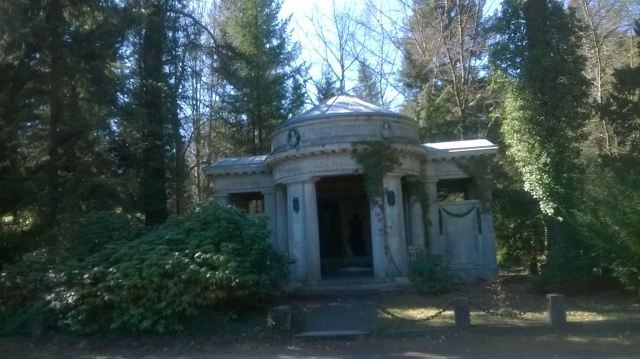
My plane was delayed by two and a half hours. Needing only hand luggage for a five day stay I breezed past the baggage carousel at Berlin-Tegel, but the taxi ride added to the delay due to traffic jams on the AVUS highway. The taxi drove through the city streets instead, which allowed me to take in all that familiar Berlin architecture looking homely inviting in the unseasonably bright and warm sunshine. It had been gray and rainy all week, but now skies were clear blue, the taxi driver informed me.
Arriving so much later than expected I had only a few minutes in my childhood home before Mom and I had to get into her car and drive down south to Stahnsdorf to make our appointment. We were supposed to be there at 11am, and it was 11:45am already. Mom had called ahead to give notice of our delay, but she was worried, because under regular circumstances they don’t schedule these appointments past noon.

The Stahnsdorf grave site of F. W. Murnau, the director of silent movie classics like “Nosferatu” and “Sunrise”
Ruhestätte Stahnsdorf is a fifteen minute drive from our home, south of Berlin just a stone’s throw away on the “other” side of where the Wall used to be. When I was growing up, Zehlendorf and Wannsee were on “our” side, the “Western” side of the Wall, and just south were Teltow and Stahnsdorf, on the “Eastern” side. Unreachable. I knew of Teltow, because the avenue Teltower Damm, as its name indicated, went south past my school towards Teltow, but was thwarted from reaching the town by those infamous Cold War concrete barriers, with sand strip, barbed wire and heavily armed border patrols just behind.

The grave of illustrator Heinrich Zille
There was no Stahnsdorfer Straße I knew about, so the town of Stahnsdorf remained out of my consciousness for most of my childhood. Until the early 1980’s that is, when a bus route was extended to reach into those two city blocks within Stahnsdorf that somehow managed to have been incorporated into the Berlin city limits in the 1920’s, and thus wound up in the American District after the fall of the Third Reich, becoming part of West Berlin when Germany divided into two. These two narrow city blocks reached like an amoeba’s branchlike offshoot into DDR territory, surrounded on three sides by the Wall and at one point as narrow as a single street. The few inhabitants there felt cut off and neglected by the city. So in the 1980s, perhaps more for reasons of politics than infrastructure, it was decided to extend the busline that serviced Wannsee into that sliver of “free” Stahnsdorf. Which is how I learned the name of the town; when one of the buslines that passed our local stop announced their new “Endstation”: Stahnsdorf.
Endstation Stahnsdorf. Terminal Stahnsdorf.

“Graveyardsection for Internment under Trees”

The Stahnsdorf memorial for victims of the Third Reich and World War 2
There used to be a train station that serviced the cemetery Stahnsdorf. From the late 1800s until World War 2 Stahnsdorf was a major if not the main cemetery for Berlin. And the S-Bahn station made it an easy destination for city dwellers. But the division of the two Germanys and the city, and especially the building of the Wall turned Ruhestätte Stahnsdorf into a nearly forgotten place, certainly a neglected place. The train station lay too close to the death strip, and station, train tracks, and railroad bridges were all dismantled by the East German government to better close and monitor the border. Even for East German citizens the cemetery became an inconvenient place to reach. Hard to get to and uncomfortably close to border fortifications. Only recently, slowly after the fall of the Berlin Wall and reunification, has Stahnsdorf begun to regain its old prominence. But it will never be as easy to reach for city dwellers as in its heyday; the train station will not be rebuilt, even if the street that passes the cemetery’s main gate is still called Bahnhofstraße.
All this was explained to us, my mother, brother, sister-in-law and myself, by the kind, softspoken official who met with us when we finally arrived at the cemetery offices. He made no issue of our time of arrival and we were never rushed as he gave us the tour of the grounds, or rather the part of the grounds that would pertain to our purpose. For Stahnsdorf Cemetery is a huge park. We walked about for a long time over a goodly stretch, but I would later gather from the map that we had traversed through only about a fourth of the vast grounds. And they are lovely grounds. Likely attracting many holiday visitors for strolls through its beautiful parks, not just family members attending to their loved ones’ graves.

 We first stopped at the chapel. Built in the Norwegian style, it is made out of wood, and is perhaps the most beautiful mid-sized church I have ever entered. It also has – musicians like Mom and I notice these things – fantastic acoustics. In fact, concerts are given all the time in the Stahnsdorfkirche. My own Flute/Harp song cycle Spreewaldlieder (Spree Forest Suite) was performed there by the Duo Elysée some years ago (read about the Spree Forest and the Spree Forest Suite here, here, here, and here). The Flautist who played then will return to Stahnsdorf to also play at my father’s funeral. The Spreewaldlieder will be heard again too, played via a cd player as the congregants enter and exit the service. Of course my mother would want music to be part of the ceremony, as would my father.
We first stopped at the chapel. Built in the Norwegian style, it is made out of wood, and is perhaps the most beautiful mid-sized church I have ever entered. It also has – musicians like Mom and I notice these things – fantastic acoustics. In fact, concerts are given all the time in the Stahnsdorfkirche. My own Flute/Harp song cycle Spreewaldlieder (Spree Forest Suite) was performed there by the Duo Elysée some years ago (read about the Spree Forest and the Spree Forest Suite here, here, here, and here). The Flautist who played then will return to Stahnsdorf to also play at my father’s funeral. The Spreewaldlieder will be heard again too, played via a cd player as the congregants enter and exit the service. Of course my mother would want music to be part of the ceremony, as would my father.
 My mother started planning how we will decorate the chapel. After all, the cross will have to be covered somehow for my ethnically Jewish, secular humanist father. Ruhestätte Stahnsdorf, once an exclusively Protestant cemetery now is open to all faiths (or no faith), although still administered by the Protestant church. Anyone can be buried here. And it is one of the few places that provides a Baumbestattung, a tree internment; and that is what we decided we wanted for my father and what brought us to Stahnsdorf.
My mother started planning how we will decorate the chapel. After all, the cross will have to be covered somehow for my ethnically Jewish, secular humanist father. Ruhestätte Stahnsdorf, once an exclusively Protestant cemetery now is open to all faiths (or no faith), although still administered by the Protestant church. Anyone can be buried here. And it is one of the few places that provides a Baumbestattung, a tree internment; and that is what we decided we wanted for my father and what brought us to Stahnsdorf.
A tree internment is what it sounds like. One is buried under a tree. It must be an urn, not a coffin, buried beside a designated tree. The tree is marked by no more than a number, but above the urn a small stone is placed, about the size of a loaf of bread, with just enough room for name, dates, and in my father’s case the Hebrew acronym we also included in his death announcement in the Tagesspiegel newspaper.

Copy of the death announcement in the Sunday edition of Der Tagesspiegel. The Hebrew acronym at the top right translates to “May his/her soul be bound in the bundle of life”.

The spot for my father’s tree internment. The American Red Oak is the tree next to my brother at right, with the green number button attached.
 Four hemispheres circle each tree. Up to four urns can be placed per hemisphere. The cemetery official explained that oaks were the best choice because many of the other trees are suffering as climate change makes Berlin’s grounds drier and drier. The oaks however are thriving in the changing conditions. But most of the big oaks were already fully reserved. Still, the southern hemisphere had just opened up at a very stately, enormous oak near the main path. We considered that spot, but then were more drawn to a young tree, only fifteen years old. An American Red Oak. We liked the sound of that for Abraham Ashkenasi, the Jewish Lefty from Brooklyn. And in time this oak would grow big and stately as Abe had been in his prime. We also loved the aspect of the location, with a big Rhododendron bush nearby just like in our garden back home, as well as tilted and sinking pre-war gravestones dotting the grounds amongst the other trees like ancient ruins.
Four hemispheres circle each tree. Up to four urns can be placed per hemisphere. The cemetery official explained that oaks were the best choice because many of the other trees are suffering as climate change makes Berlin’s grounds drier and drier. The oaks however are thriving in the changing conditions. But most of the big oaks were already fully reserved. Still, the southern hemisphere had just opened up at a very stately, enormous oak near the main path. We considered that spot, but then were more drawn to a young tree, only fifteen years old. An American Red Oak. We liked the sound of that for Abraham Ashkenasi, the Jewish Lefty from Brooklyn. And in time this oak would grow big and stately as Abe had been in his prime. We also loved the aspect of the location, with a big Rhododendron bush nearby just like in our garden back home, as well as tilted and sinking pre-war gravestones dotting the grounds amongst the other trees like ancient ruins.

We are the first family to choose this tree, and thus we had all hemispheres from which to choose. Mom initially thought she would prefer west, because my father had come from the West, from America, to live, and die, in Berlin. But once at the chosen tree, surveying the spot, she decided the southern hemisphere would suit my father best. His urn will look like mother of pearl, but will actually be made from biodegradable materials. In three weeks it will be placed in the chapel, surrounded by blue and white flowers. An American and Israeli flag as well as photographs of my father and his family from throughout his time on Earth will add to the decorations (and hide the cross from view) during the sharing of eulogies and remembrances in the chapel. Then the congregation will follow the urn as it is carried along the picturesque park paths to its tree and permanent home. The urn will be buried and the inscribed stone placed above. And my father’s ashes will in time become part of the American Red Oak as it grows large and tall in the years to come.

Another oak with tree internment grave stones.

A partial map of the Stahnsdorf grounds. The tree internment is in “Lietzensee”, the WW2 memorial above it in the upper #20, the Norwegian Chapel in the center above “Kapellenblock”.

A grand family mausoleum, as was popular among the wealthy around 1900

Old grave stones now residing within the tree internment section of Stahnsdorf

beautifully written and photographed – Cathy
LikeLiked by 1 person
Christa and I will have to visit when we are there for the month of June. What a lovely idea about the oak tree.
LikeLiked by 1 person
Thank you for taking us along as you chose the perfect burial site for you father. The biodegradable urn is especially appropriate. Love, Mim
LikeLiked by 1 person
Dear family Ashkenasi,
As one of his students I knew AA in the years 1968-1974 and, as an Israeli, we had always a lot to talk. Very moving your words, Danny, about his last days. “Avi” was new for me, I knew him as “Abe”.
If you need some Hebrew text get in touch with me.
Warm regards and best wishes.
mao
LikeLiked by 1 person